Adaptation of Inductive Power Transfer to Small Household Appliances That Can Operate on Induction Heating Cooktops: Wireless Electric Kettle
Abstract
1. Introduction
- Power transfer is provided without using a compensation component. (In this way, the size of the small household appliance does not increase, and the cost is low as the desired operation is achieved with the least number of elements.)
- The system is capable of using the existing IH cooktop as a transmitter stage. (Eliminates the need for an additional transmitter stage.)
- A wide range of power is provided to the load, from 10% to 100% of its rated power. (Power transfer can be provided to high-power SHAs such as kettles, hot pots, rice cookers, toasters, etc.)
2. Principles of IPT
3. Design Criteria of the System
- Changes to be made to the product should not change its characteristics;
- Must be able to operate in a wide AC main voltage range;
- It should be highly efficient according to Ki cordless kitchen standards;
- Must be able to transfer the maximum power value specified in Ki cordless kitchen standards;
- It should also provide low-power transfers during the keep warm function;
- The coupling coefficient between the transmit and receive coils must be high;
- Coil diameters must be compatible with the base diameter of the existing kettle and IH cooktop coils.
4. Design
4.1. Magnetic System Design
4.2. Power Circuit and Control Design
5. System Simulations
6. Experimental Results
7. Conclusions
Author Contributions
Funding
Data Availability Statement
Acknowledgments
Conflicts of Interest
References
- He, H.; Wang, S.; Liu, Y.; Jiang, C.; Wu, X.; Wei, B.; Jiang, B. Maximum Efficiency Tracking for Dynamic WPT System Based on Optimal Input Voltage Matching. IEEE Access 2020, 8, 215224–215234. [Google Scholar] [CrossRef]
- Shu, X.; Xiao, W.; Zhang, B. Wireless Power Supply for Small Household Appliances Using Energy Model. IEEE Access 2018, 6, 69592–69602. [Google Scholar] [CrossRef]
- Pedder, D.; Brown, A.; Skinner, J. A contactless electrical energy transmission system. IEEE Trans. Ind. Electron. 1999, 46, 23–30. [Google Scholar] [CrossRef]
- Covic, G.A.; Boys, J.T. Inductive Power Transfer. Proc. IEEE 2013, 101, 1276–1289. [Google Scholar] [CrossRef]
- Jiang, Y.; Zhang, B.; Zhou, J. A Fractional-Order Resonant Wireless Power Transfer System with Inherently Constant Current Output. IEEE Access 2020, 8, 23317–23323. [Google Scholar] [CrossRef]
- Qi, C.; Lang, Z.; Su, L.; Chen, X.; Miao, H. Model Predictive Control for a Bidirectional Wireless Power Transfer System with Maximum Efficiency Point Tracking. In Proceedings of the 2019 IEEE International Symposium on Predictive Control of Electrical Drives and Power Electronics (PRECEDE 2019), Quanzhou, China, 31 May–2 June 2019; pp. 1–5. [Google Scholar]
- Patil, D.; McDonough, M.K.; Miller, J.M.; Fahimi, B.; Balsara, P.T. Wireless Power Transfer for Vehicular Applications: Overview and Challenges. IEEE Trans. Transp. Electrif. 2018, 4, 3–37. [Google Scholar] [CrossRef]
- Abe, H.; Sakamoto, H.; Harada, K. A noncontact charger using a resonant converter with parallel capacitor of the secondary coil. IEEE Trans. Ind. Appl. 2000, 36, 444–451. [Google Scholar] [CrossRef]
- Mayordomo, I.; Dräger, T.; Spies, P.; Bernhard, J.; Pflaum, A. An overview of technical challenges and advances of inductive wireless power transmission. Proc. IEEE 2013, 101, 1302–1311. [Google Scholar] [CrossRef]
- Kracek, J.; Svanda, M. Analysis of Capacitive Wireless Power Transfer. IEEE Access 2019, 7, 26678–26683. [Google Scholar] [CrossRef]
- Nguyen, M.T.; Nguyen, C.V.; Truong, L.H.; Le, A.M.; Quyen, T.V.; Masaracchia, A.; Teague, K.A. Electromagnetic Field Based WPT Technologies for UAVs: A Comprehensive Survey. Electronics 2020, 9, 461. [Google Scholar] [CrossRef]
- Hsieh, Y.-C.; Lin, Z.-R.; Chen, M.-C.; Hsieh, H.-C.; Liu, Y.-C.; Chiu, H.-J. High-Efficiency Wireless Power Transfer System for Electric Vehicle Applications. IEEE Trans. Circuits Syst. II Express Briefs 2017, 64, 942–946. [Google Scholar] [CrossRef]
- Mude, K.N.; Aditya, K. Comprehensive review and analysis of two-element resonant compensation topologies for wireless inductive power transfer systems. Chin. J. Electr. Eng. 2019, 5, 14–31. [Google Scholar] [CrossRef]
- Lin, J.C. Safety of Wireless Power Transfer. IEEE Access 2021, 9, 125342–125347. [Google Scholar] [CrossRef]
- Van Mulders, J.; Delabie, D.; Lecluyse, C.; Buyle, C.; Callebaut, G.; Van der Perre, L.; De Strycker, L. Wireless Power Transfer: Systems, Circuits, Standards, and Use Cases. Sensors 2022, 22, 5573. [Google Scholar] [CrossRef] [PubMed]
- Topuz, N.E.; Dawood, K.; Kaya, U.; Odabas, G.; Komurgoz, G. Electromagnetic and Thermal Analysis of a Domestic Induction Cooker Coil. In Proceedings of the 2019 4th International Conference on Power Electronics and Their Applications (ICPEA 2019), Elazig, Turkey, 25–27 September 2019; pp. 1–5. [Google Scholar] [CrossRef]
- Shevchenko, V.; Husev, O.; Strzelecki, R.; Pakhaliuk, B.; Poliakov, N.; Strzelecka, N. Compensation Topologies in IPT Systems: Standards, Requirements, Classification, Analysis, Comparison and Application. IEEE Access 2019, 7, 120559–120580. [Google Scholar] [CrossRef]
- Wang, Z.; Li, Y.; Sun, Y.; Tang, C.; Dai, X. An Efficiency Optimization Strategy with Segmented Optimal Frequency in the Common Inductive Power Transfer Platform. Inf. Technol. J. 2013, 12, 1512–1521. [Google Scholar] [CrossRef]
- Wu, L.; Zhang, B.; Jiang, Y.; Zhou, J. A Robust Parity-Time-Symmetric WPT System with Extended Constant-Power Range for Cordless Kitchen Appliances. IEEE Trans. Ind. Appl. 2022, 58, 1179–1189. [Google Scholar] [CrossRef]
- Tritschler, J.; Goeldi, B.; Reichert, S.; Griepentrog, G. Comparison of different control strategies for series-series compensated inductive power transmission systems. In Proceedings of the 2015 17th European Conference on Power Electronics and Applications (EPE’15 ECCE-Europe 2015), Geneva, Switzerland, 8–10 September 2015; pp. 1–8. [Google Scholar] [CrossRef]
- Sezer, C.; Odabas, G.; Sinirlioglu, S.; Kaya, B.; Altintas, N. Modeling of WPT System for Small Home Appliances. In Proceedings of the 14th Regional Conference on Electrical and Electronics Engineering (RC-EEE 2021), Bangkok, Thailand, 3 December 2021; pp. 243–247. [Google Scholar] [CrossRef]
- Wilamowski, B.M.; Irwin, J.D. The Industrial Electronics Handbook Power Electronics and Motor Drives; CRC Press Taylor and Francis Group: Boca Raton, FL, USA, 2011. [Google Scholar]
- Itraj, M.; Ettes, W. Topology study for an inductive power transmitter for cordless kitchen appliances. In Proceedings of the IEEE PELS Workshop on Emerging Technologies: Wireless Power Transfer (Wow), Seoul, Korea, 15–19 November 2018; pp. 1–8. [Google Scholar] [CrossRef]
- Luo, S.; Zhang, Z.; Li, G.; Yao, Z.; Zhang, X.; Ma, H. A Primary Shunt Inductor Compensated Inductive Power Transfer System with Natural ZVS for Battery Charging Application. In Proceedings of the 2021 IEEE 1st International Power Electronics and Application Symposium (PEAS 2021), Shanghai, China, 13–15 November 2021; pp. 1–6. [Google Scholar] [CrossRef]
- WPC. Ki Cordless Kitchen: From Concept to Industry Standard; White Paper; Wireless Power Consortium: Piscataway, NJ, USA, 2019; Available online: https://www.wirelesspowerconsortium.com/data/downloadables/2/3/7/5/ki-cordless-kitchen-white-paper-september-2019.pdf (accessed on 12 May 2022).
- Vreede, J. The Wireless Kitchen: Introducing Inductive Power Transfer in the Kitchen Environment. Master’s Thesis, Department of Electronic Engineering, Delft University of Technology, Delft, The Netherlands, 2013. [Google Scholar]
- WPC. Cordless Kitchen Appliances: A Powerful New Kitchen Concept; White Paper; Wireless Power Consortium: Piscataway, NJ, USA, 2013; Available online: https://www.wirelesspowerconsortium.com/data/downloadables/1/1/0/5/201304-white-paper-cordless-kitchen-appliances.pdf (accessed on 12 May 2022).
- Plumed, E.; Lope, I.; Acero, J.; Burdio, J.M. Domestic Induction Heating System with Standard Primary Inductor for Reduced-Size and High Distance Cookware. IEEE Trans. Ind. Appl. 2022, 58, 7562–7571. [Google Scholar] [CrossRef]
- Plumed, E.; Acero, J.; Lope, I.; Burdío, J.M. Design methodology of high performance domestic induction heating systems under worktop. IET Power Electron. 2020, 13, 300–306. [Google Scholar] [CrossRef]
- Yin, N.X.; Saat, S.; Husin, S.H.; Yusop, Y.; Awal, M.R. The design of IPT system for multiple kitchen appliances using class E LCCL circuit. Int. J. Electr. Comput. Eng. 2020, 10, 3483–3491. [Google Scholar] [CrossRef]
- Xia, Z.; Li, J.; Li, S.; Wan, J.; Wu, L.; Wang, Z.; Wang, S. A Wireless Induction Heating Rice Cooker with SCCC Compensation Network. In Proceedings of the International Conference on Electrical Machines, Valencia, Spain, 5–8 September 2022; pp. 1–5. [Google Scholar] [CrossRef]
- Plumed, E.; Lope, I.; Acero, J.; Burdio, J.M. Inductor System Evaluation for Simultaneous Wireless Energy Transfer and Induction Heating. In Proceedings of the IECON 2018—44th Annual Conference of the IEEE Industrial Electronics Society, Washington, DC, USA, 21–23 October 2018; pp. 3509–3514. [Google Scholar] [CrossRef]
- Nutwong, S.; Sangswang, A.; Naetiladdanon, S.; Mujjalinvimut, E. A Novel Output Power Control of Wireless Powering Kitchen Appliance System with Free-Positioning Feature. Energies 2018, 11, 1671. [Google Scholar] [CrossRef]
- Hui, S.Y.R.; Zhong, W.; Lee, C.K. A Critical Review of Recent Progress in Mid-Range Wireless Power Transfer. IEEE Trans. Power Electron. 2013, 29, 4500–4511. [Google Scholar] [CrossRef]
- Zhang, Z.; Pang, H.; Georgiadis, A.; Cecati, C. Wireless Power Transfer—An Overview. IEEE Trans. Ind. Electron. 2019, 66, 1044–1058. [Google Scholar] [CrossRef]
- Hurley, W.; Wilcox, D. Calculation of leakage inductance in transformer windings. IEEE Trans. Power Electron. 1994, 9, 121–126. [Google Scholar] [CrossRef]
- Sinirlioglu, S.; Aksoy, I. Independent from cookware ferromagnetic characteristics transferring maximum power each cookware on domestic induction cooktops. In Proceedings of the National Conference on Electrical, Electronics and Biomedical Engineering (ELECO), Bursa, Turkey, 1–3 December 2016; pp. 382–386. [Google Scholar]
- Li, S.; Mi, C.C. Wireless Power Transfer for Electric Vehicle Applications. IEEE J. Emerg. Sel. Top. Power Electron. 2015, 3, 4–17. [Google Scholar] [CrossRef]
- Wang, Z.-H.; Li, Y.-P.; Sun, Y.; Tang, C.-S.; Lv, X. Load detection model of voltage-fed ınductive power transfer system. IEEE Trans. Power Electron. 2013, 28, 5233–5243. [Google Scholar] [CrossRef]
- IEC 61000-3-2; Electromagnetic Compatibility (EMC) Limits. Limits for Harmonic Current Emissions (Equipment Input Current ≤16 A Per Phase). IEC: Geneva, Switzerland, 2020.
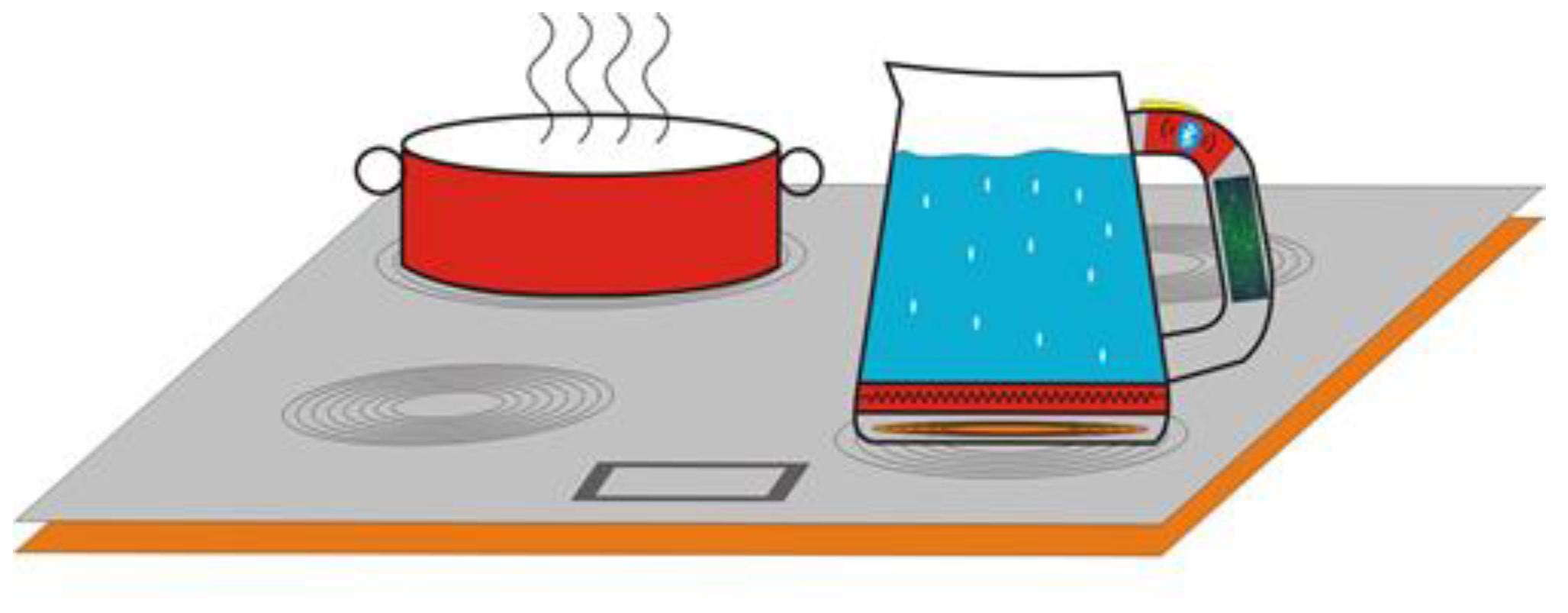
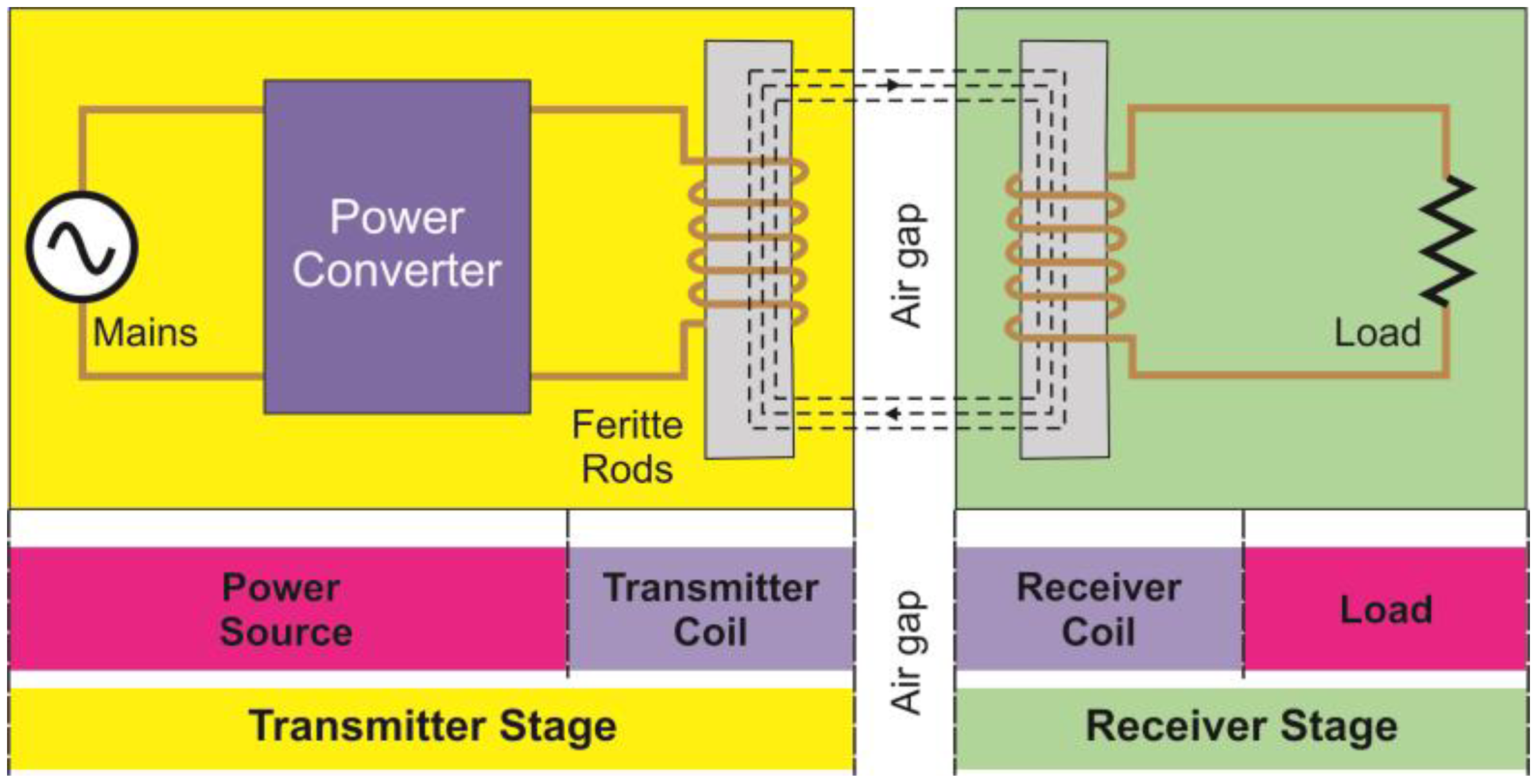
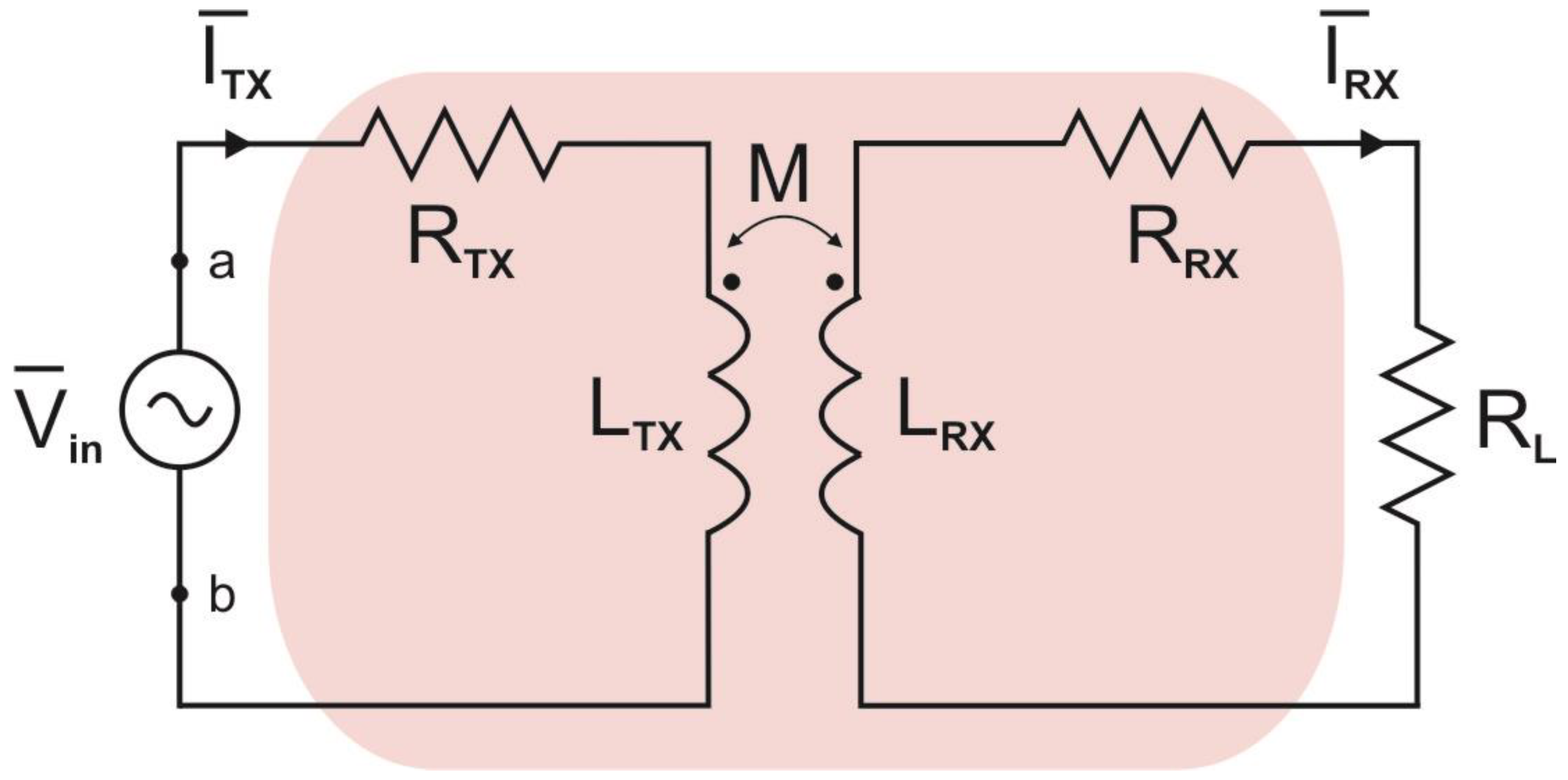
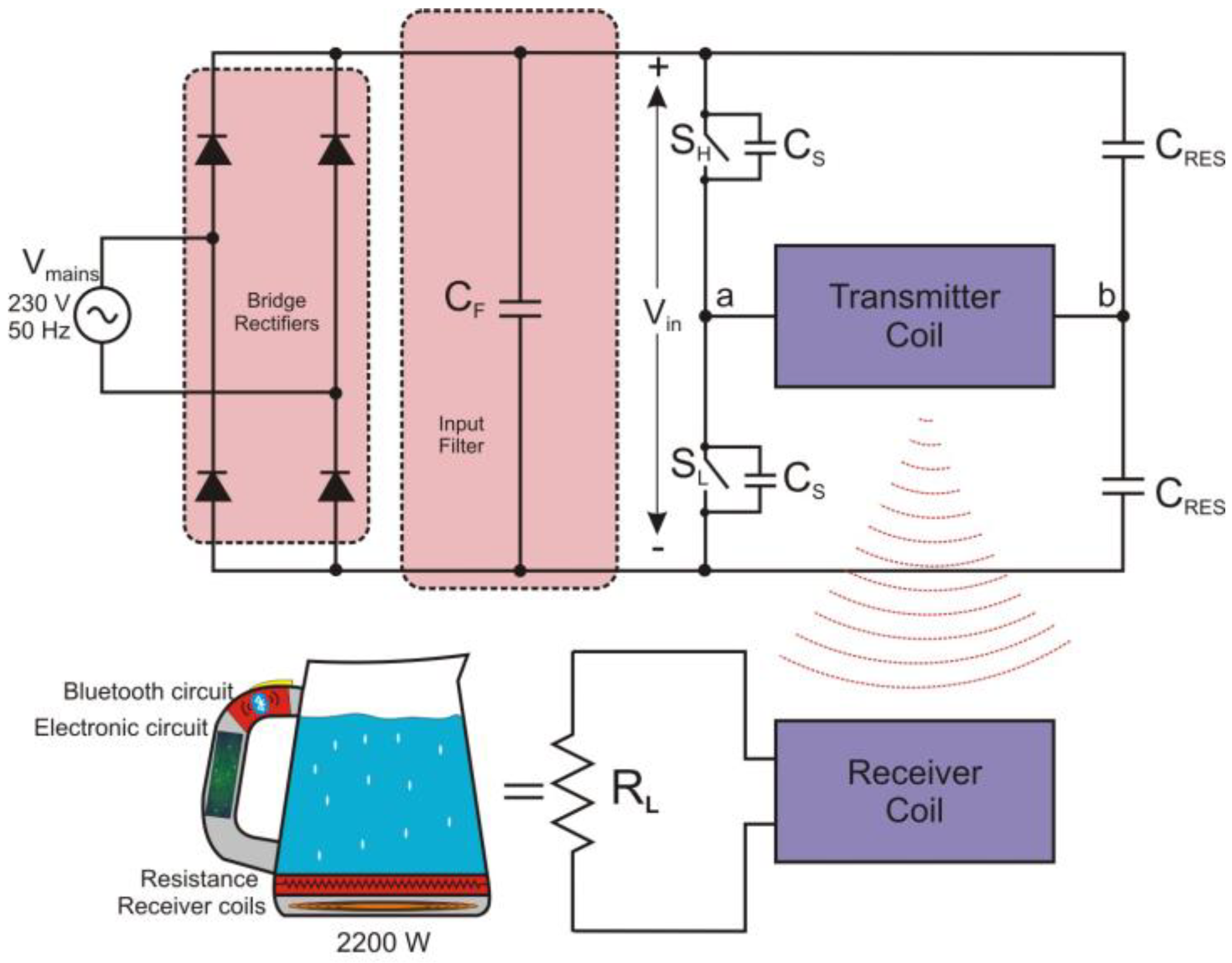

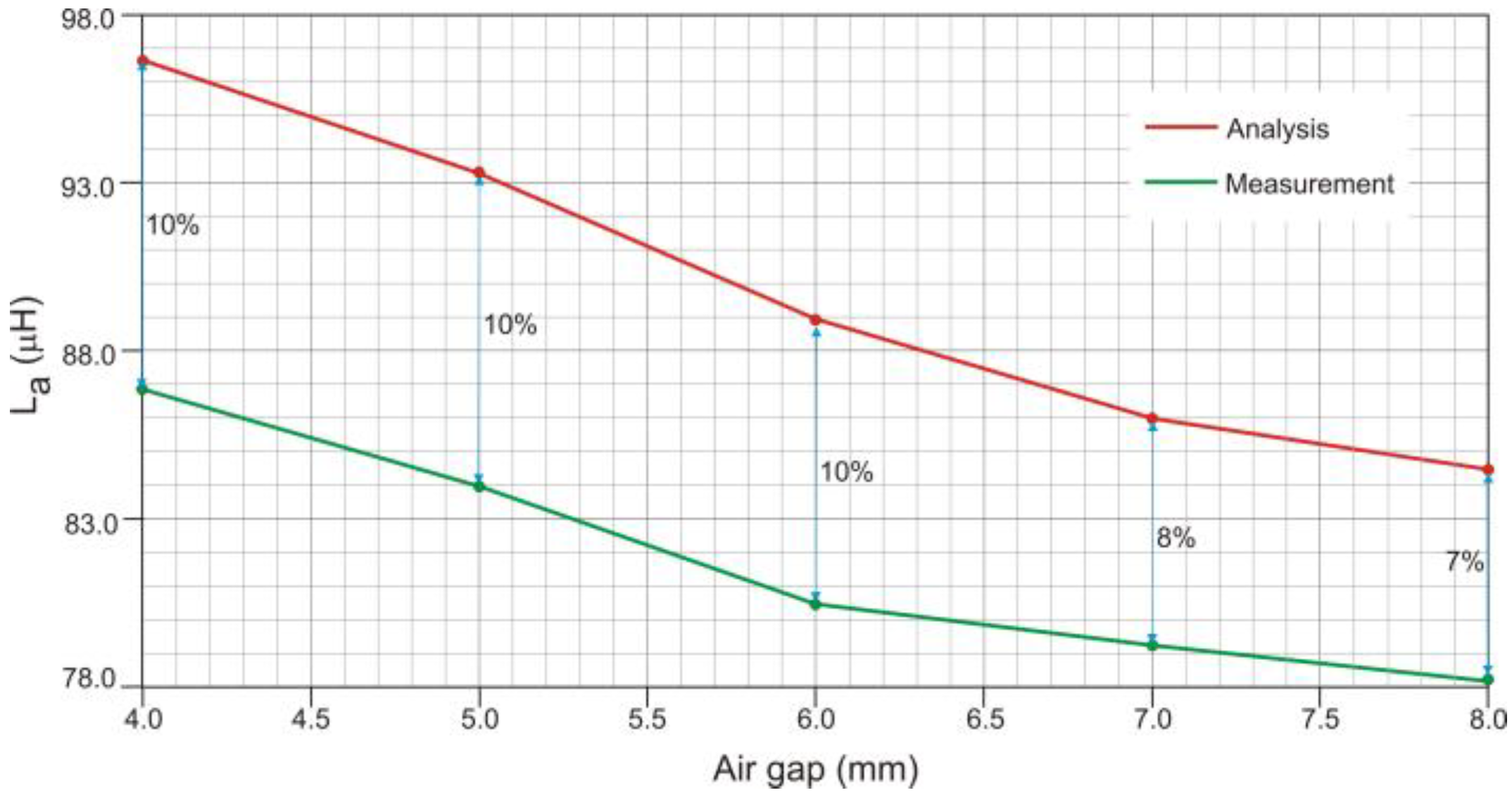
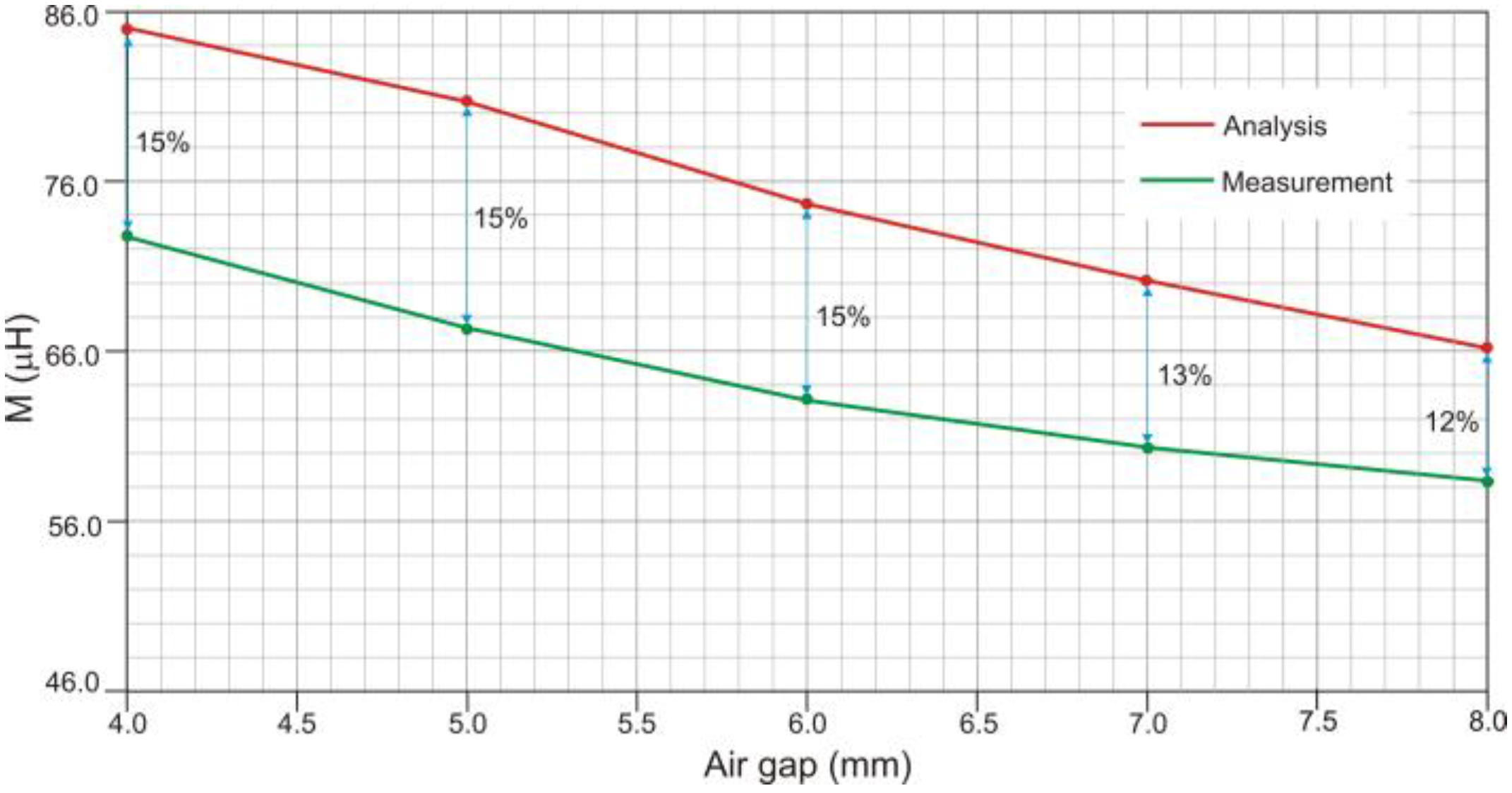
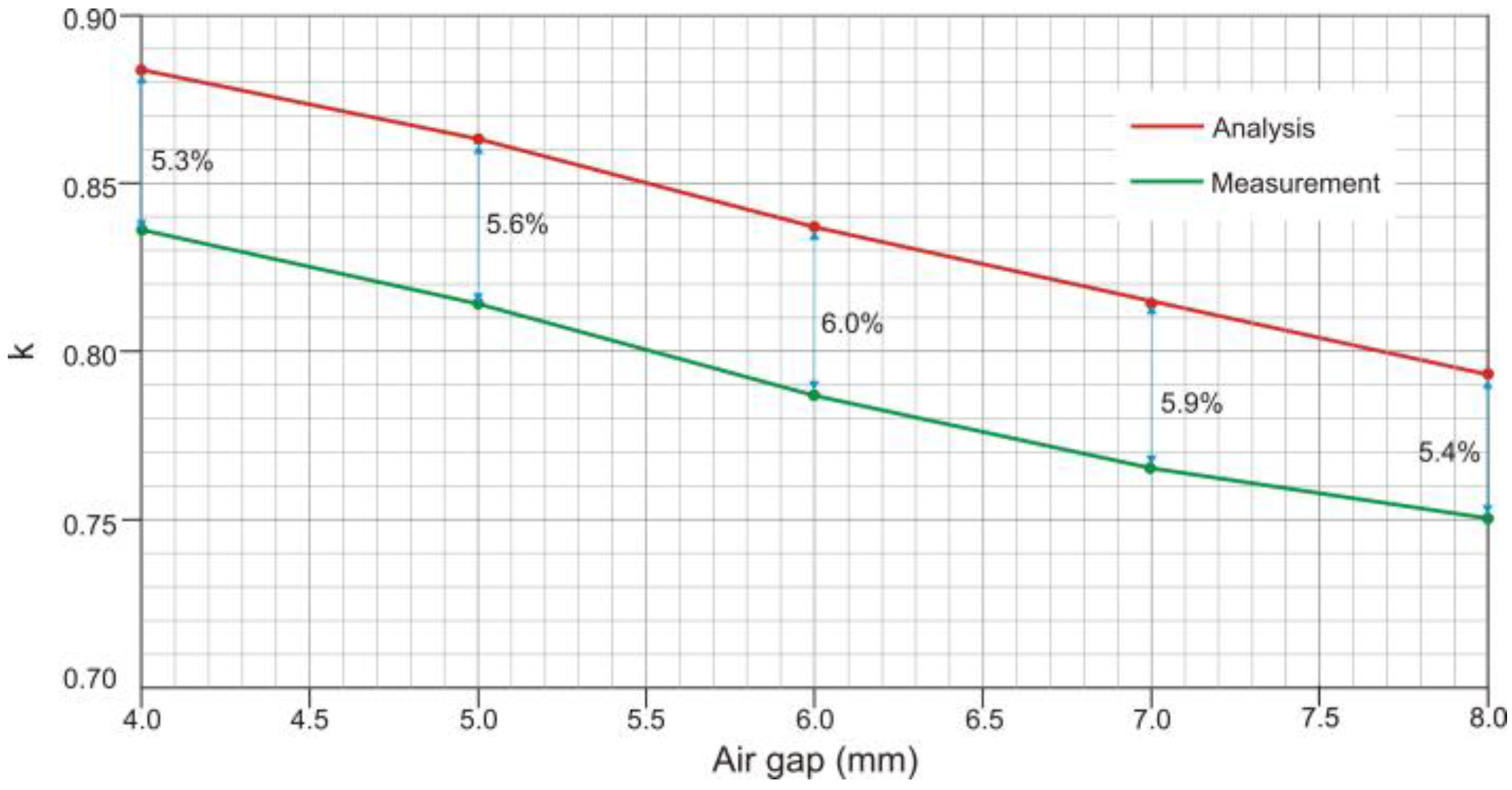

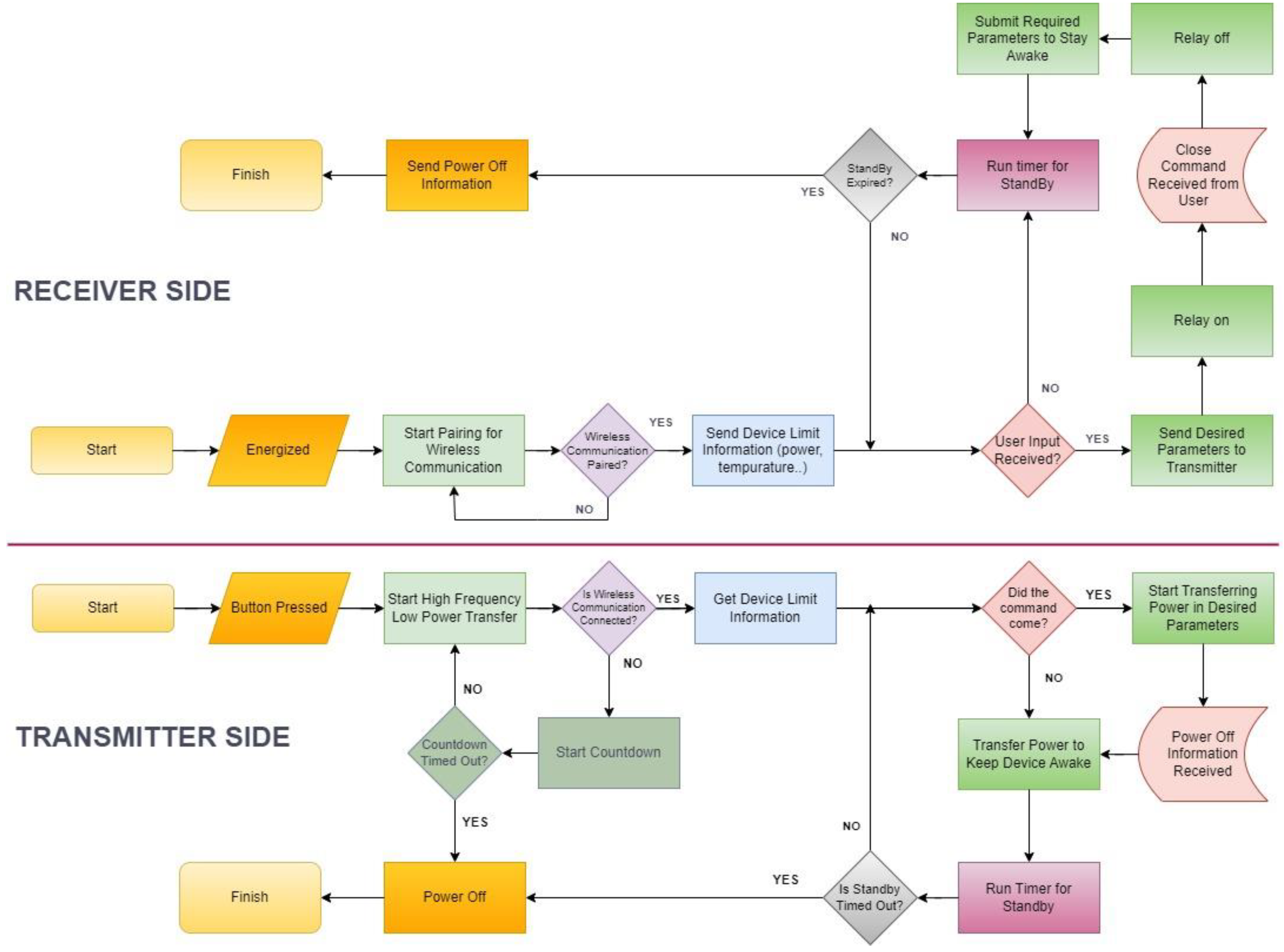

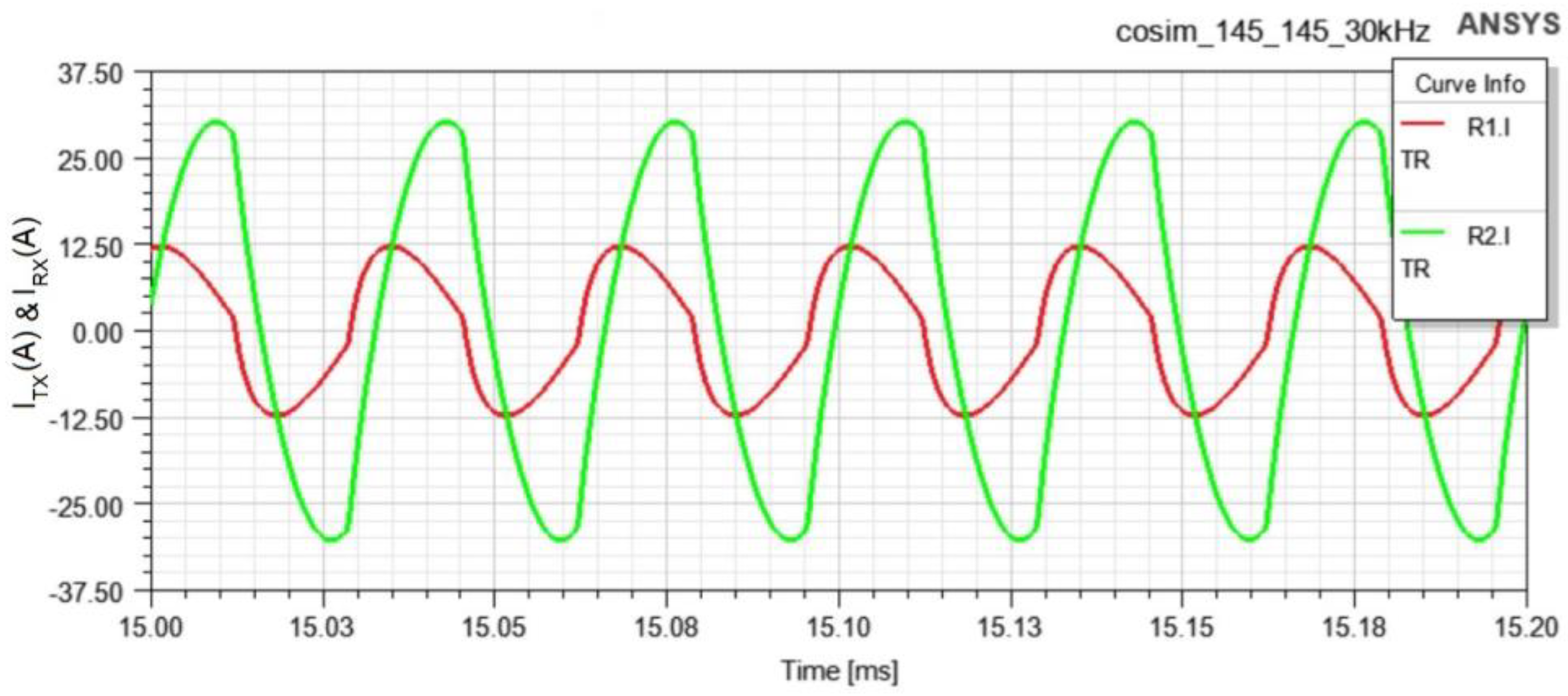
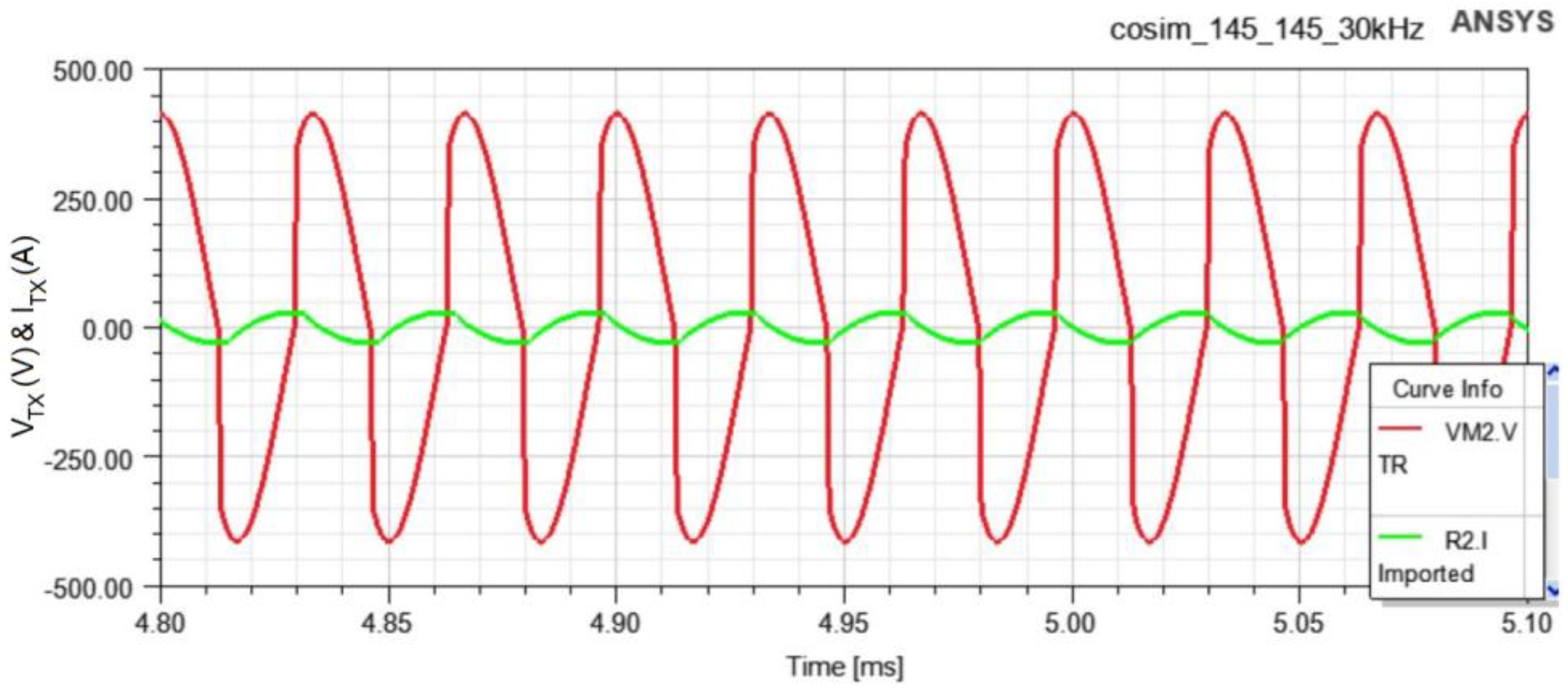
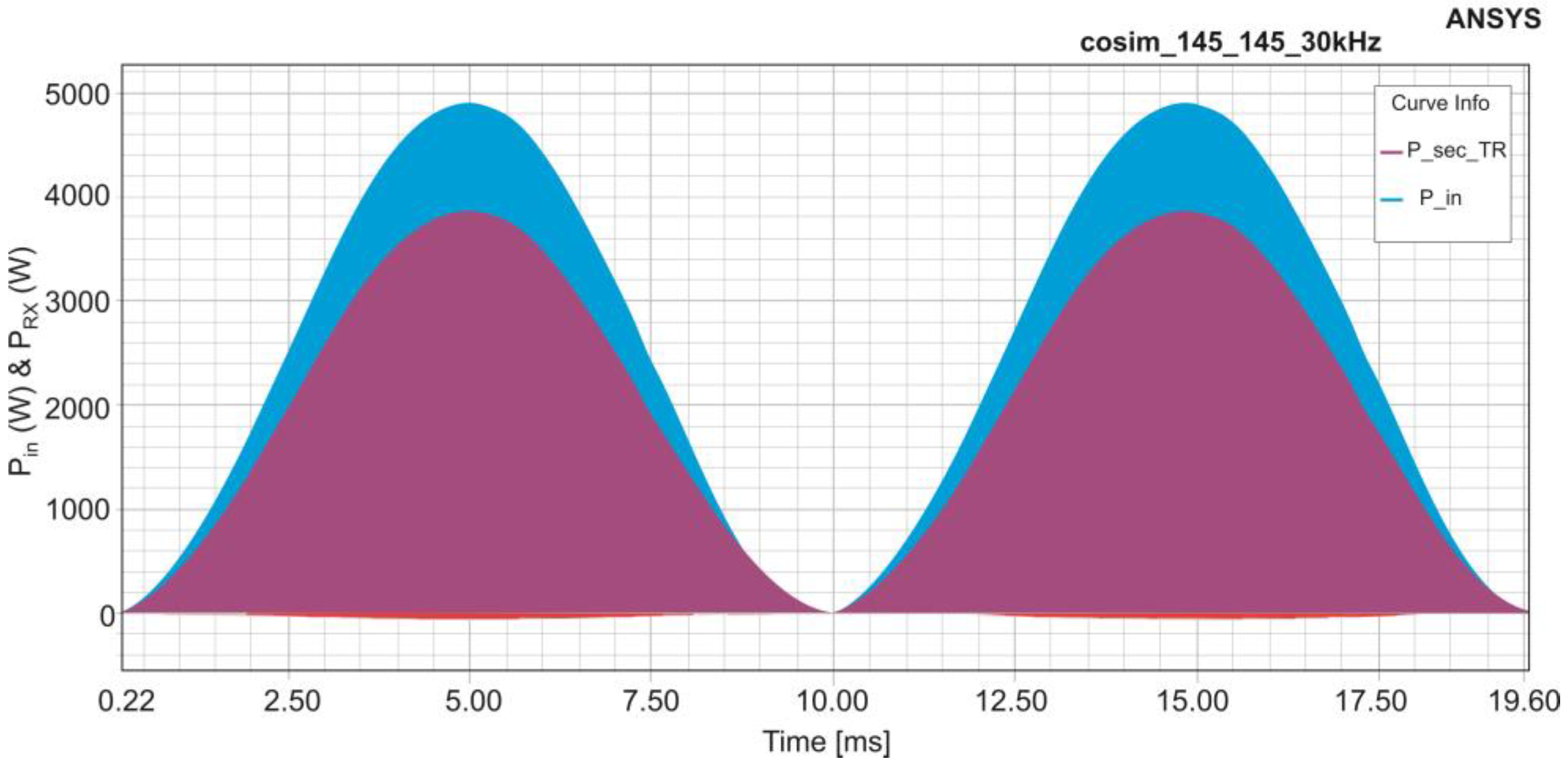
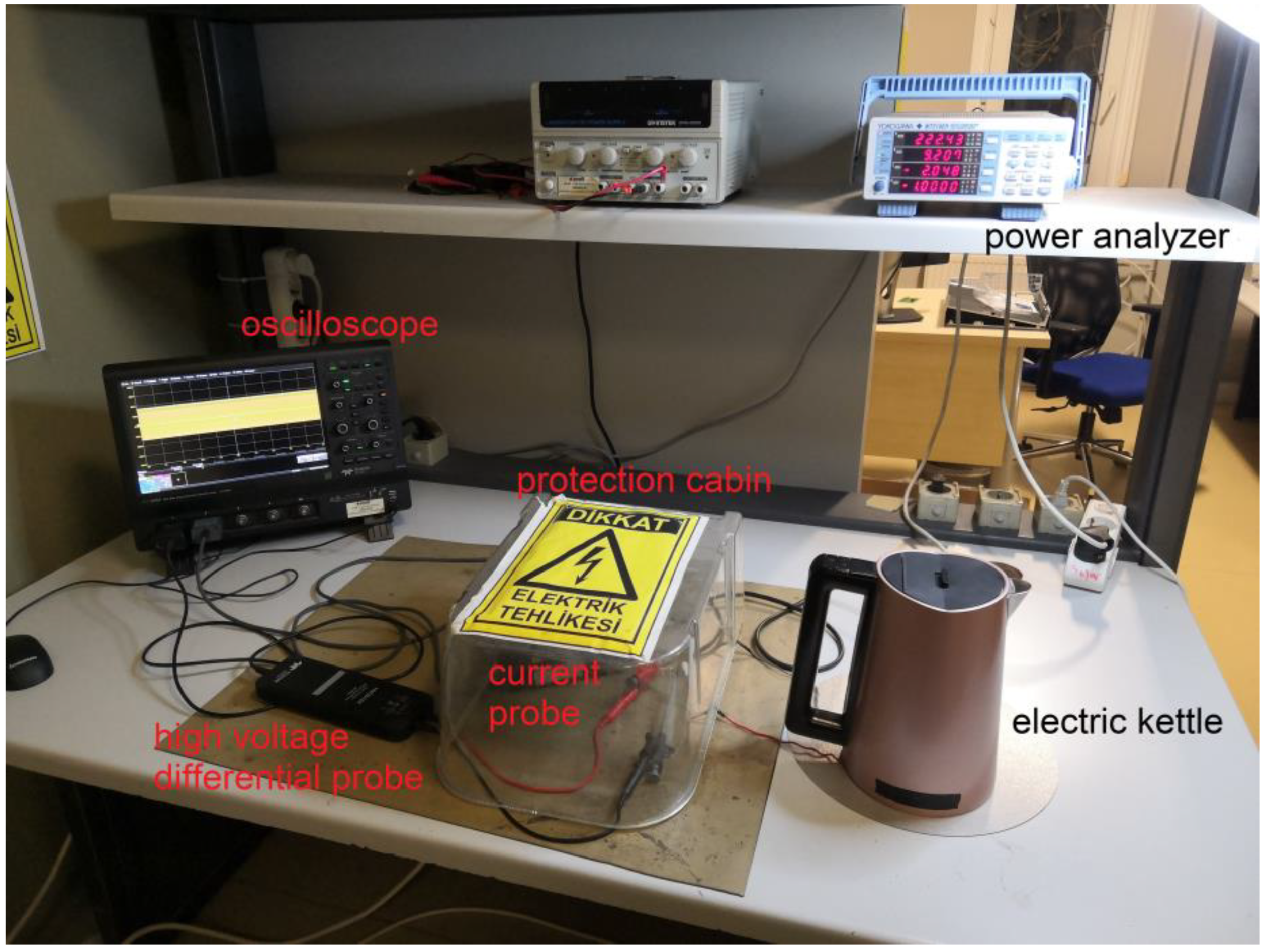



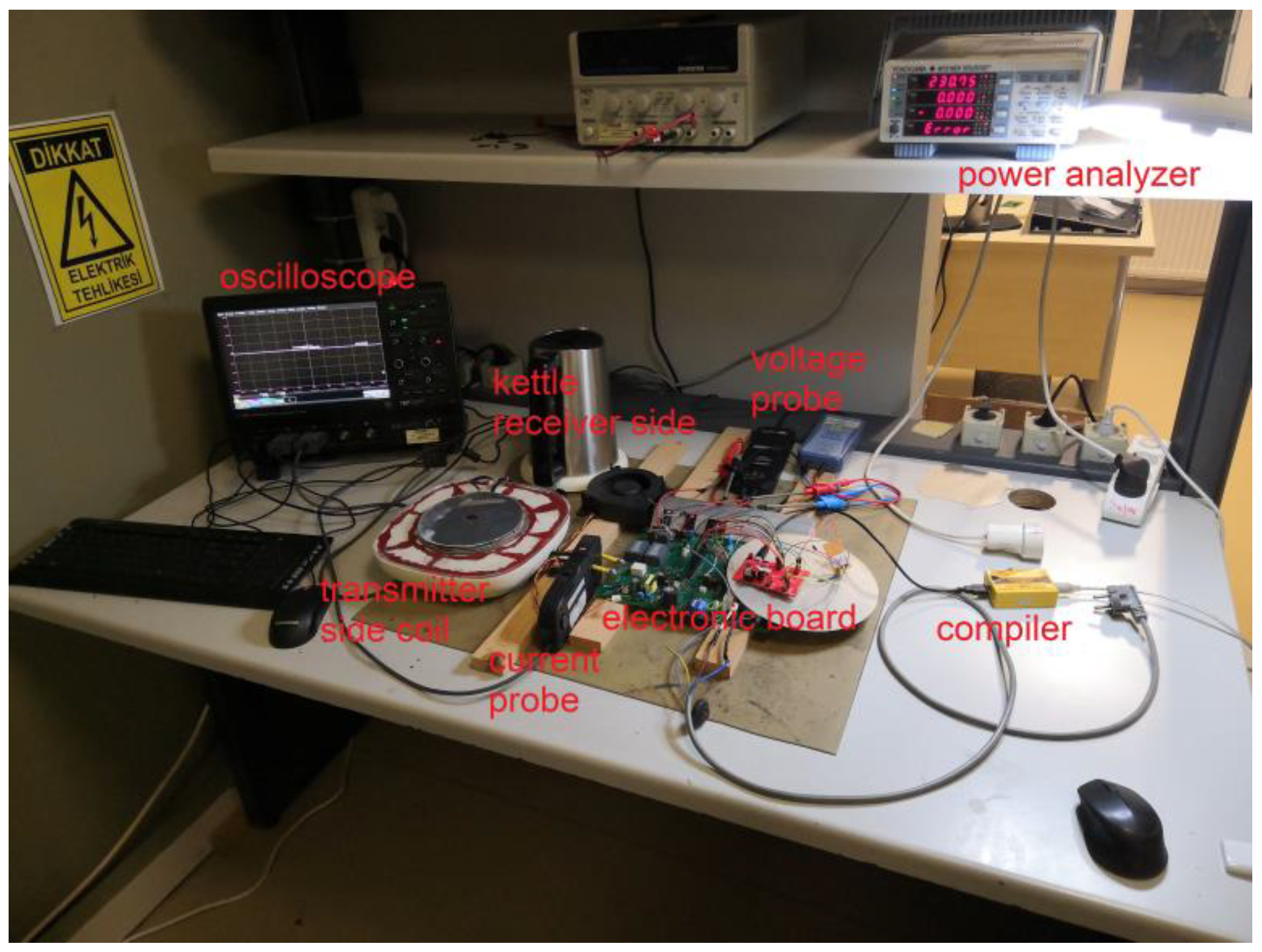
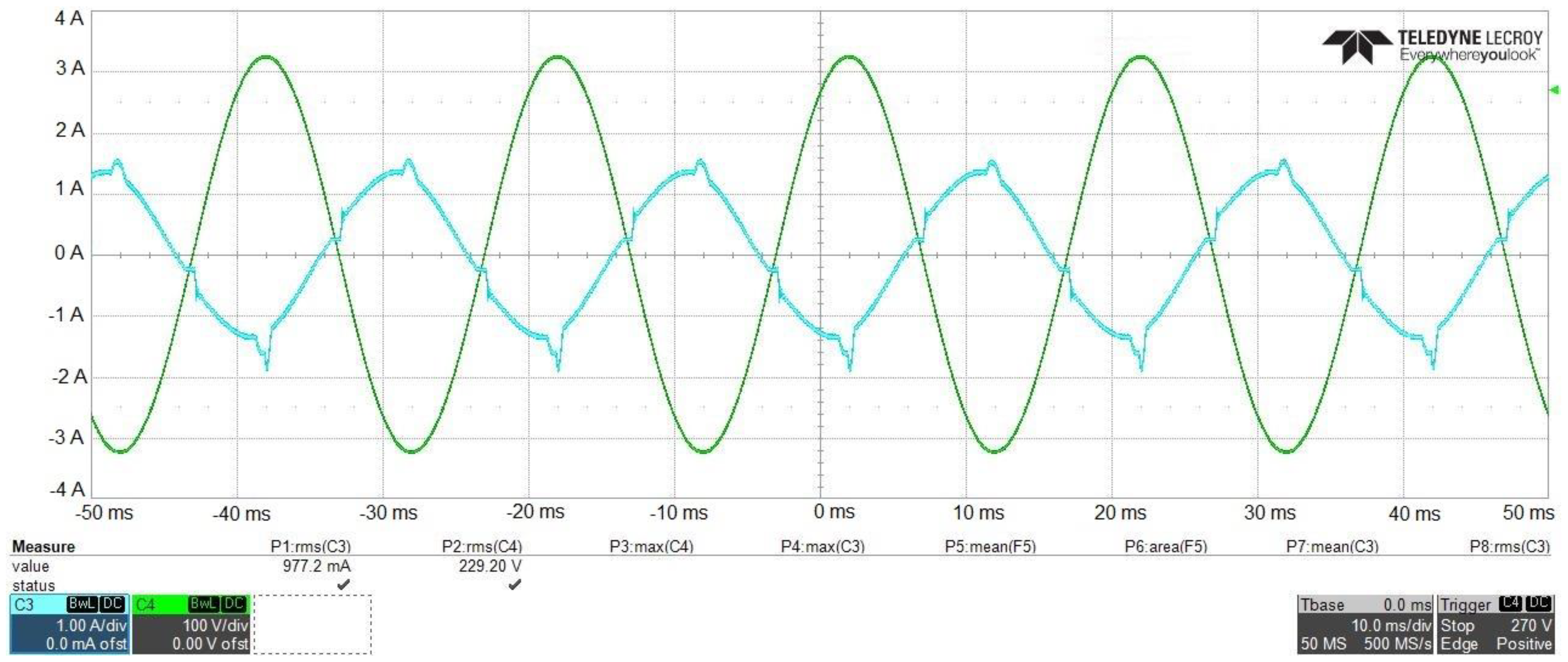

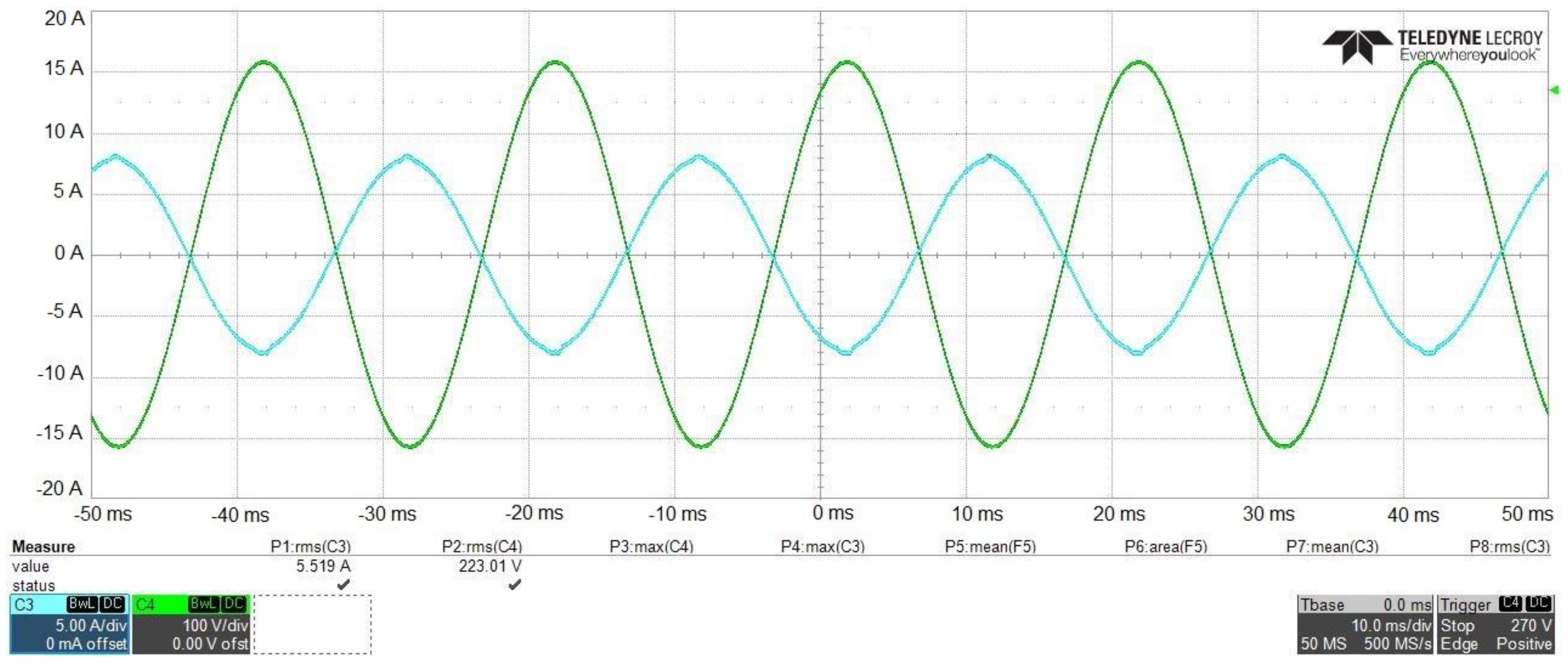
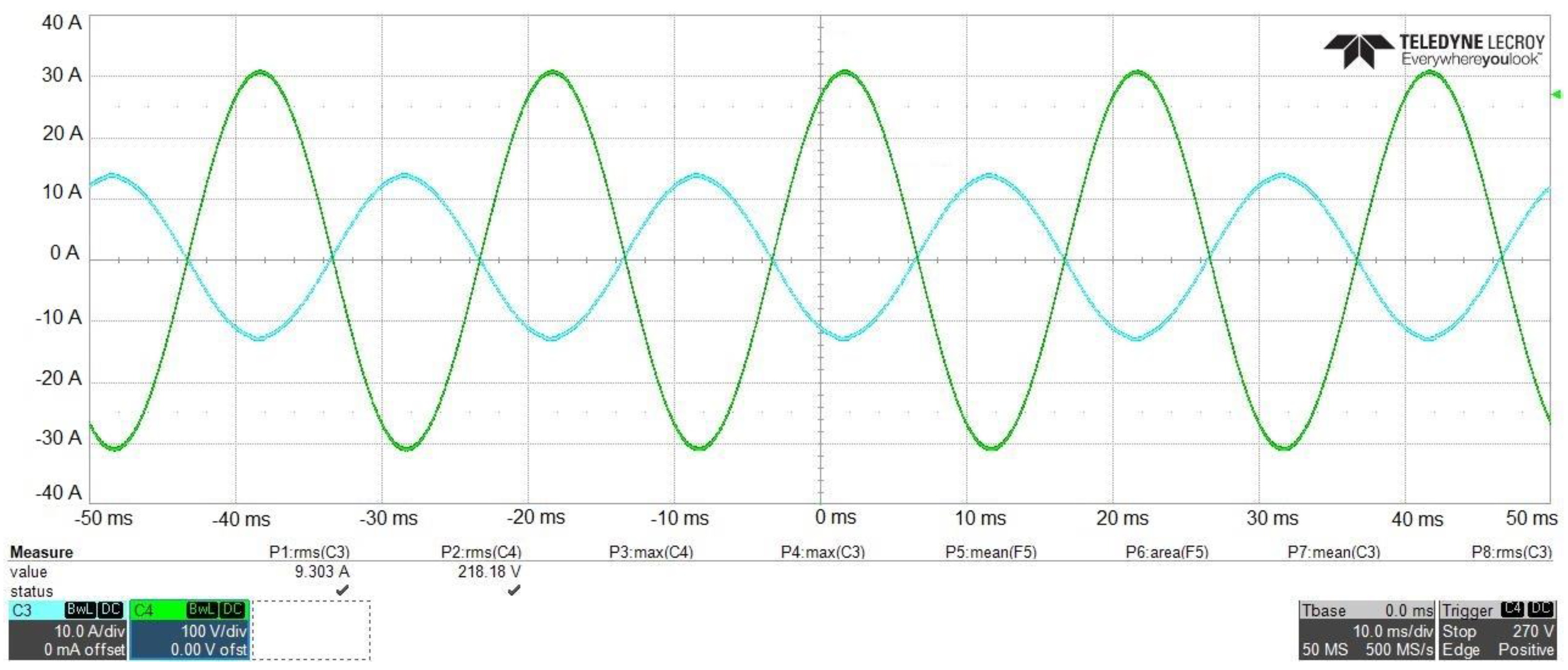
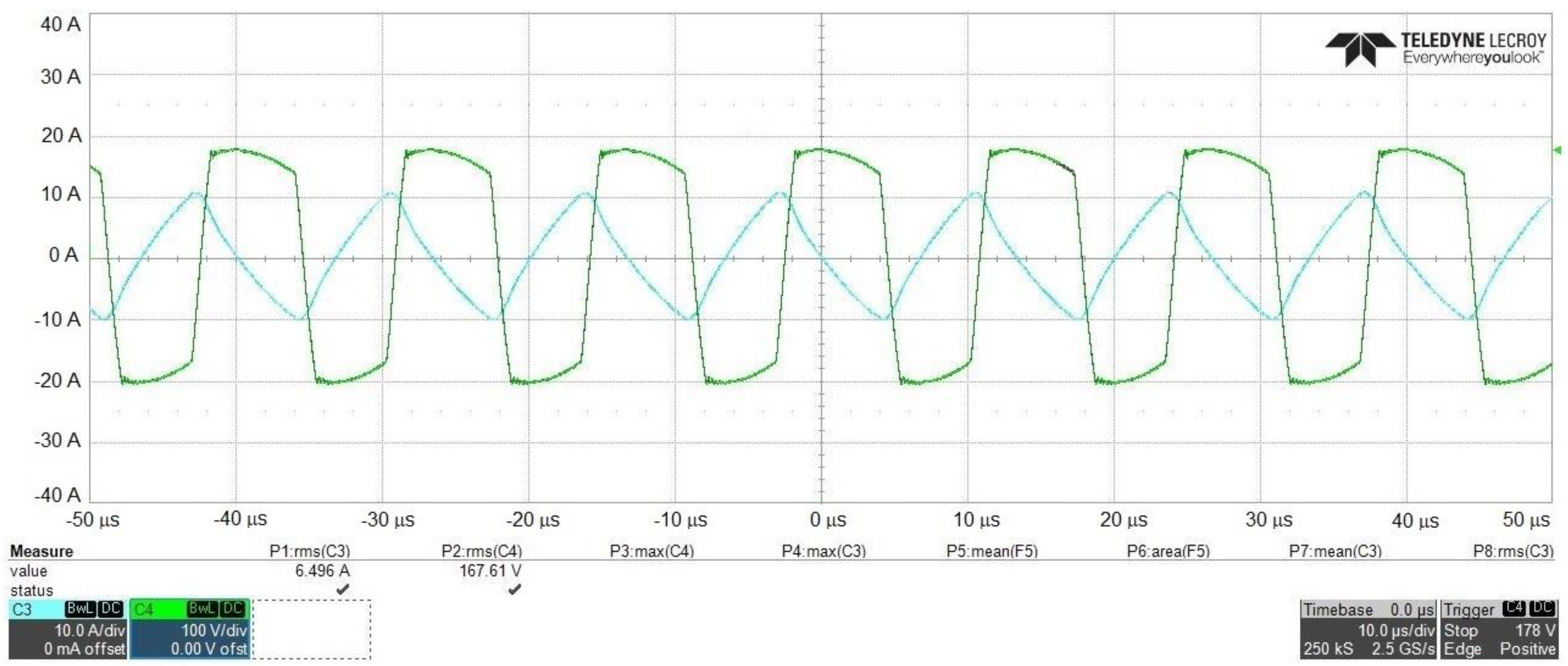


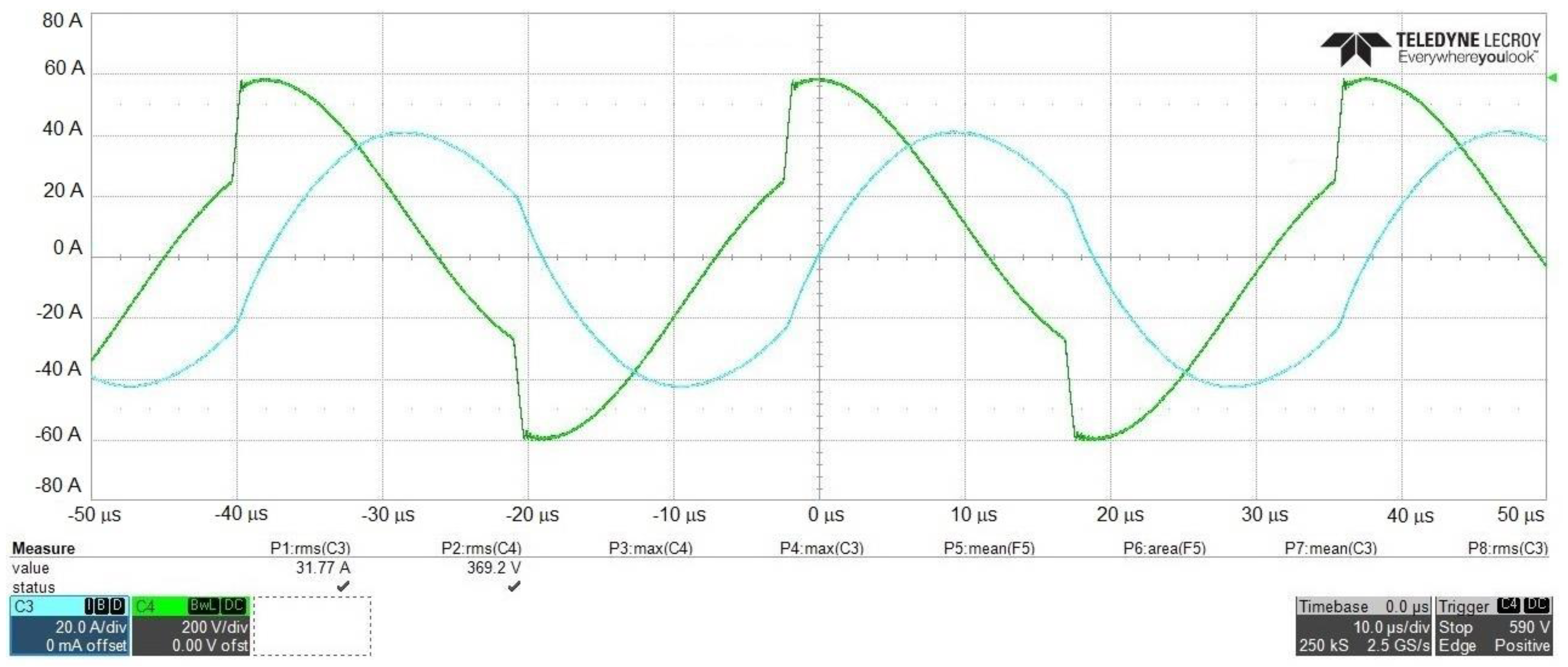
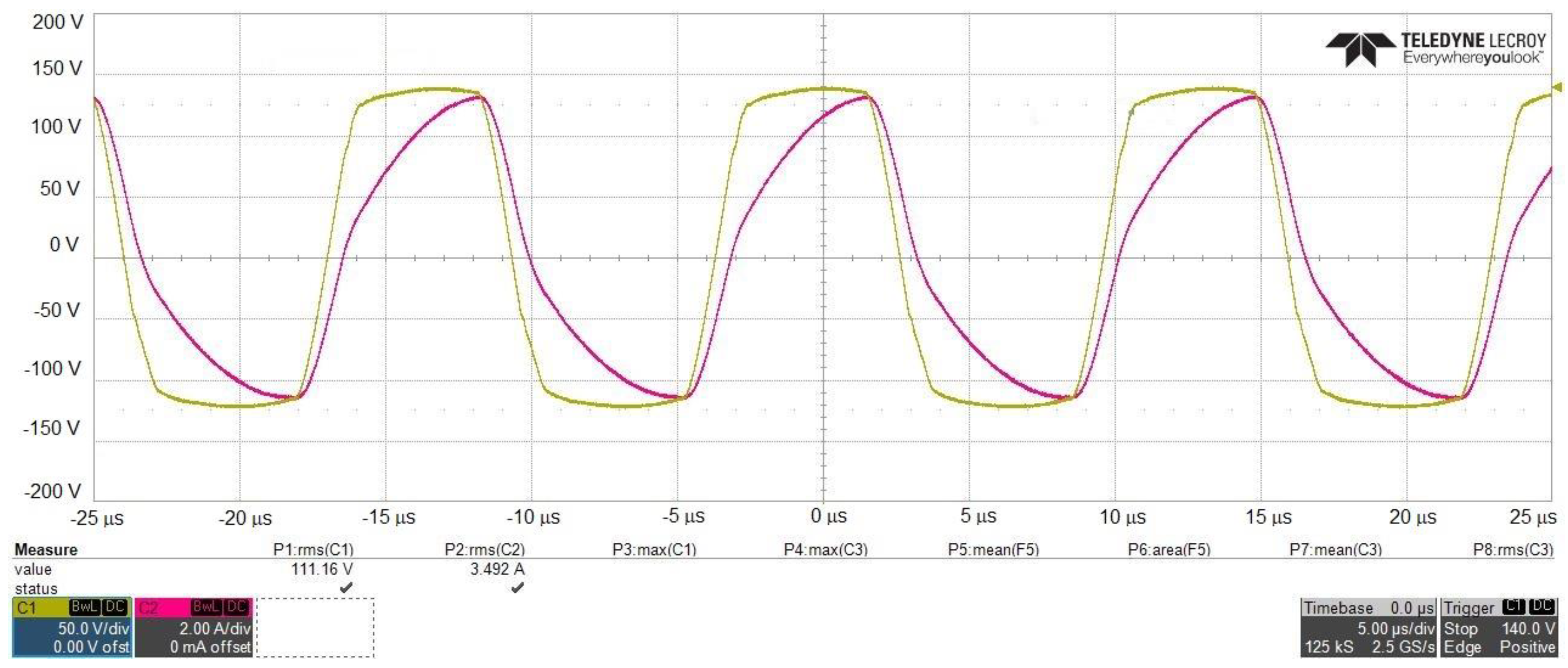

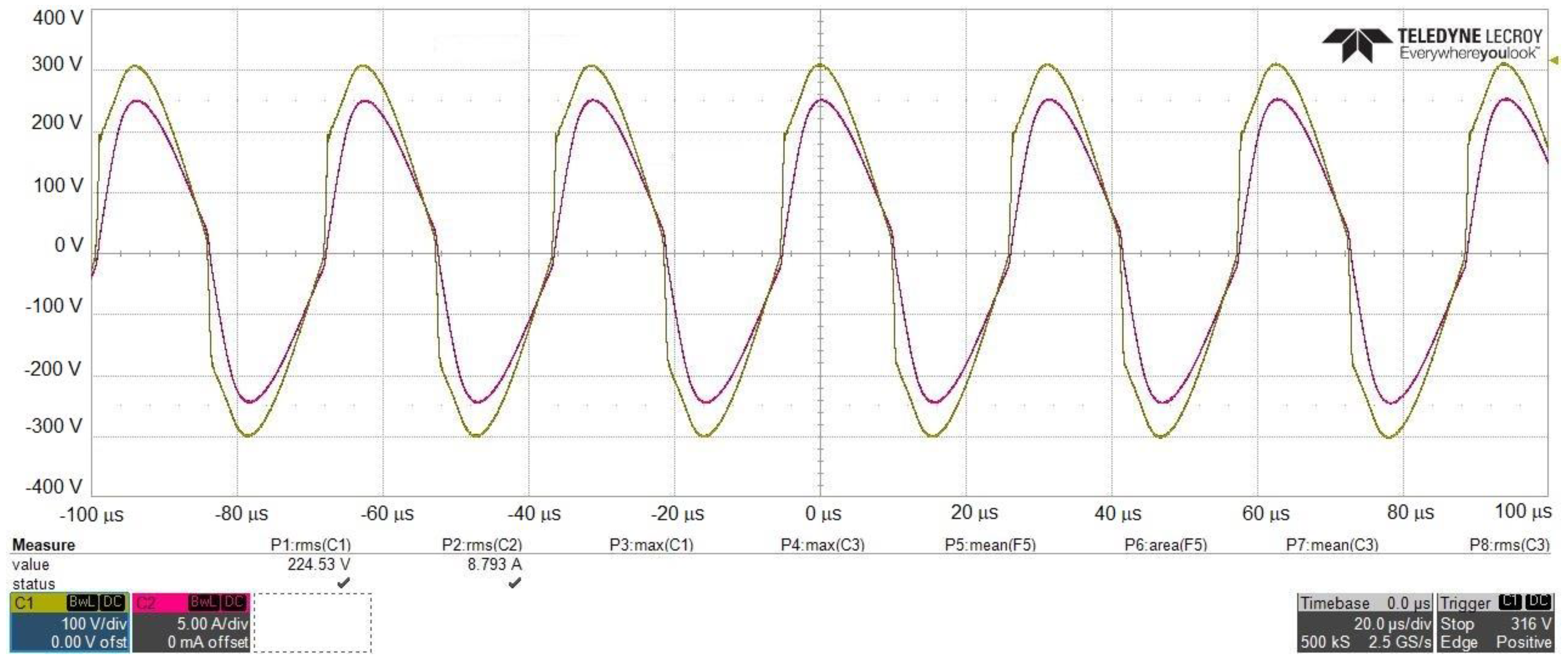
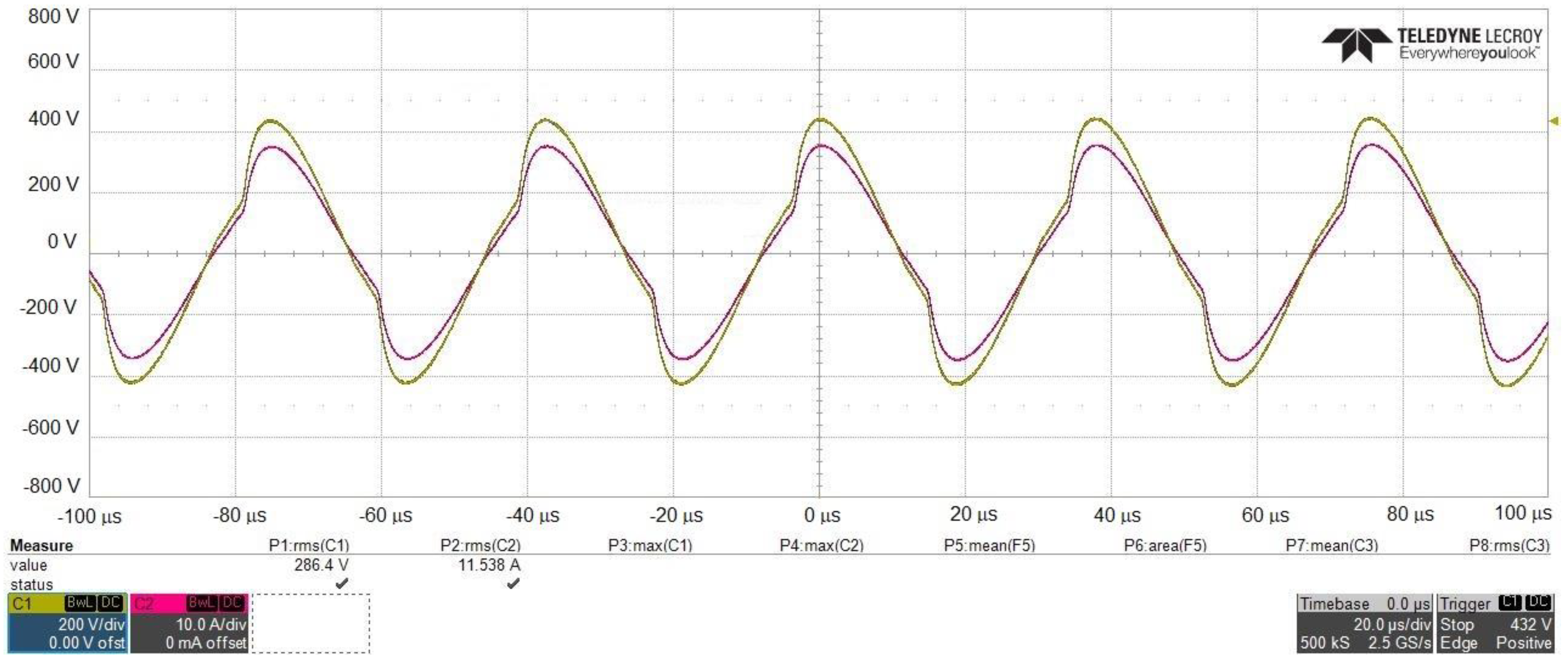
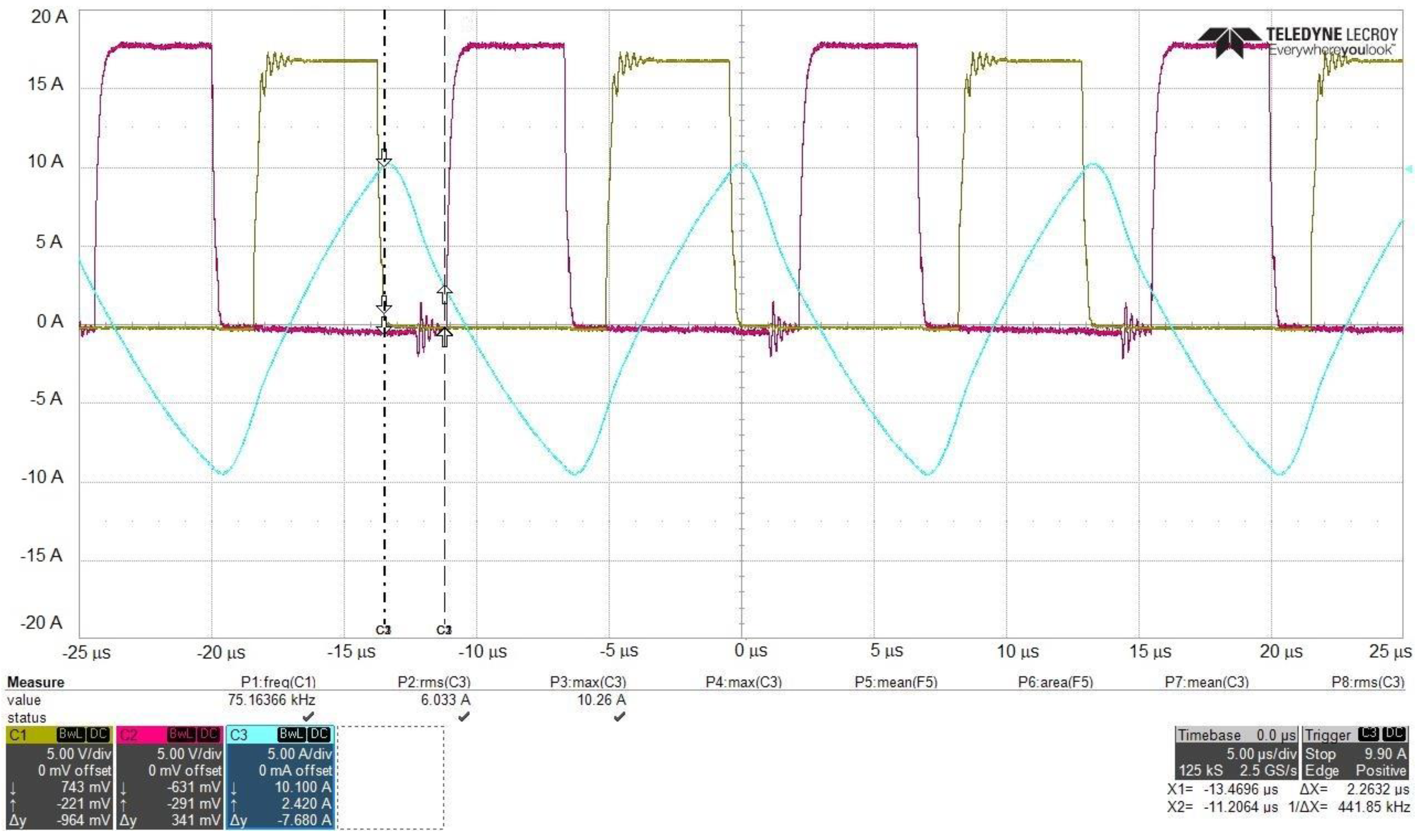


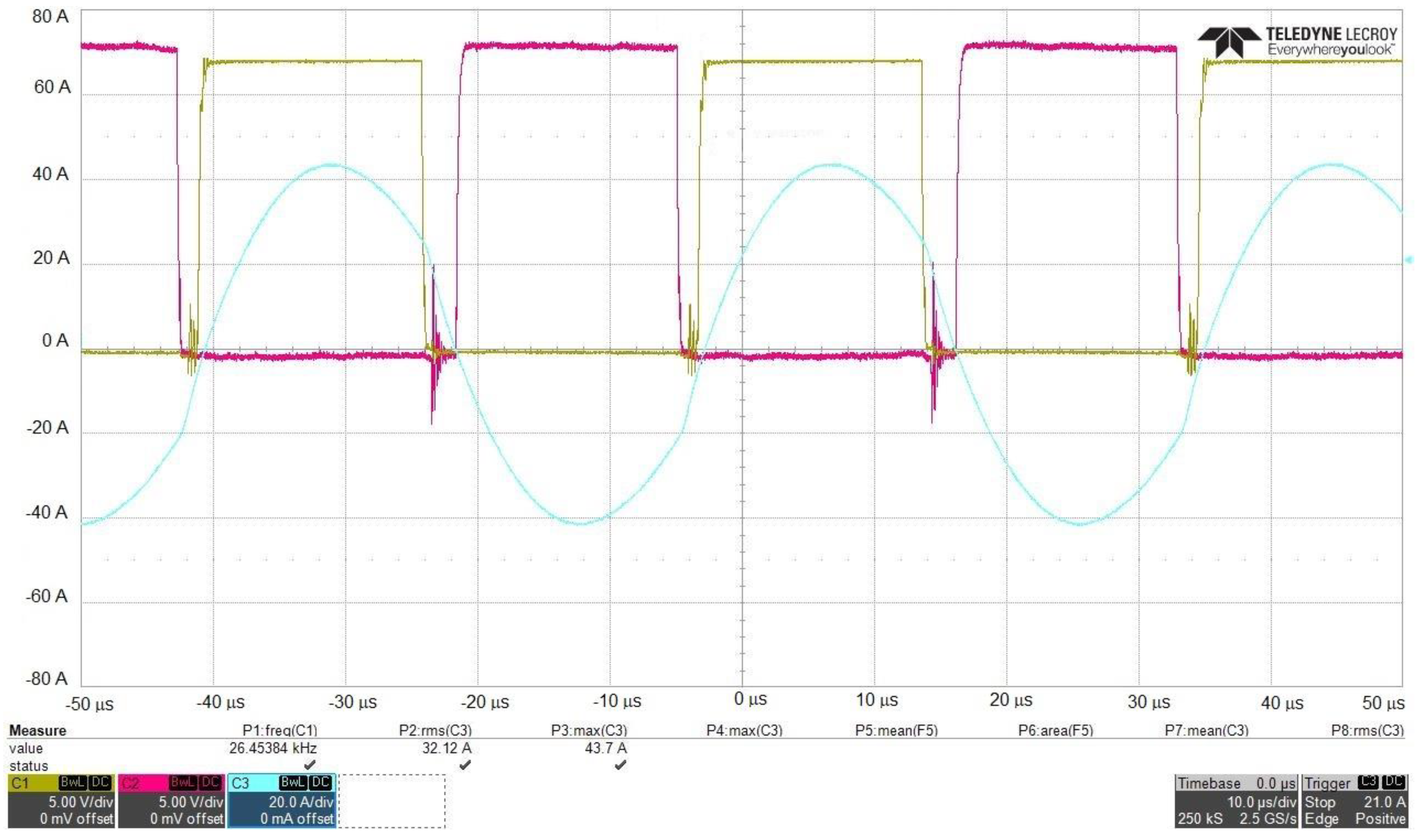
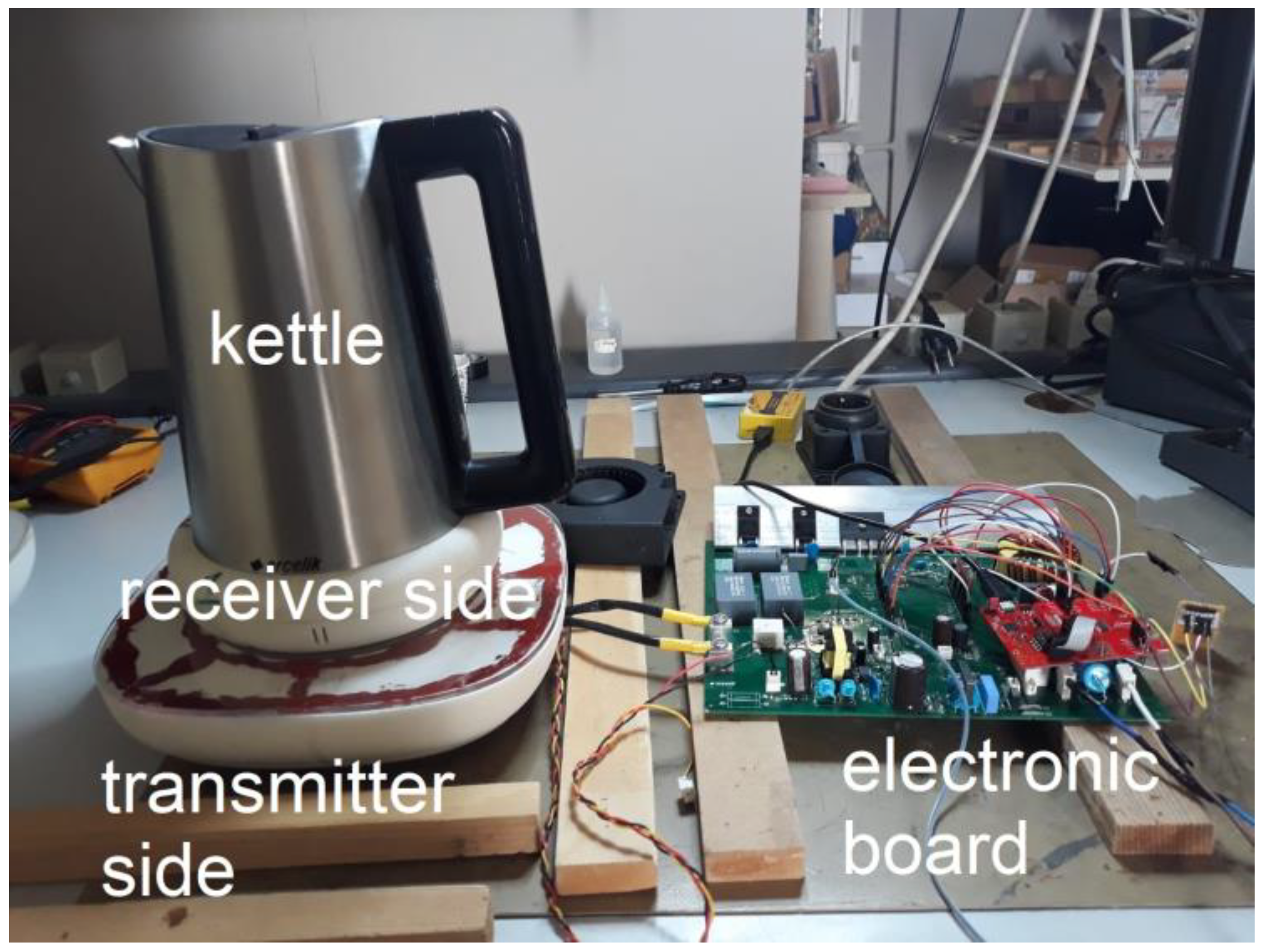

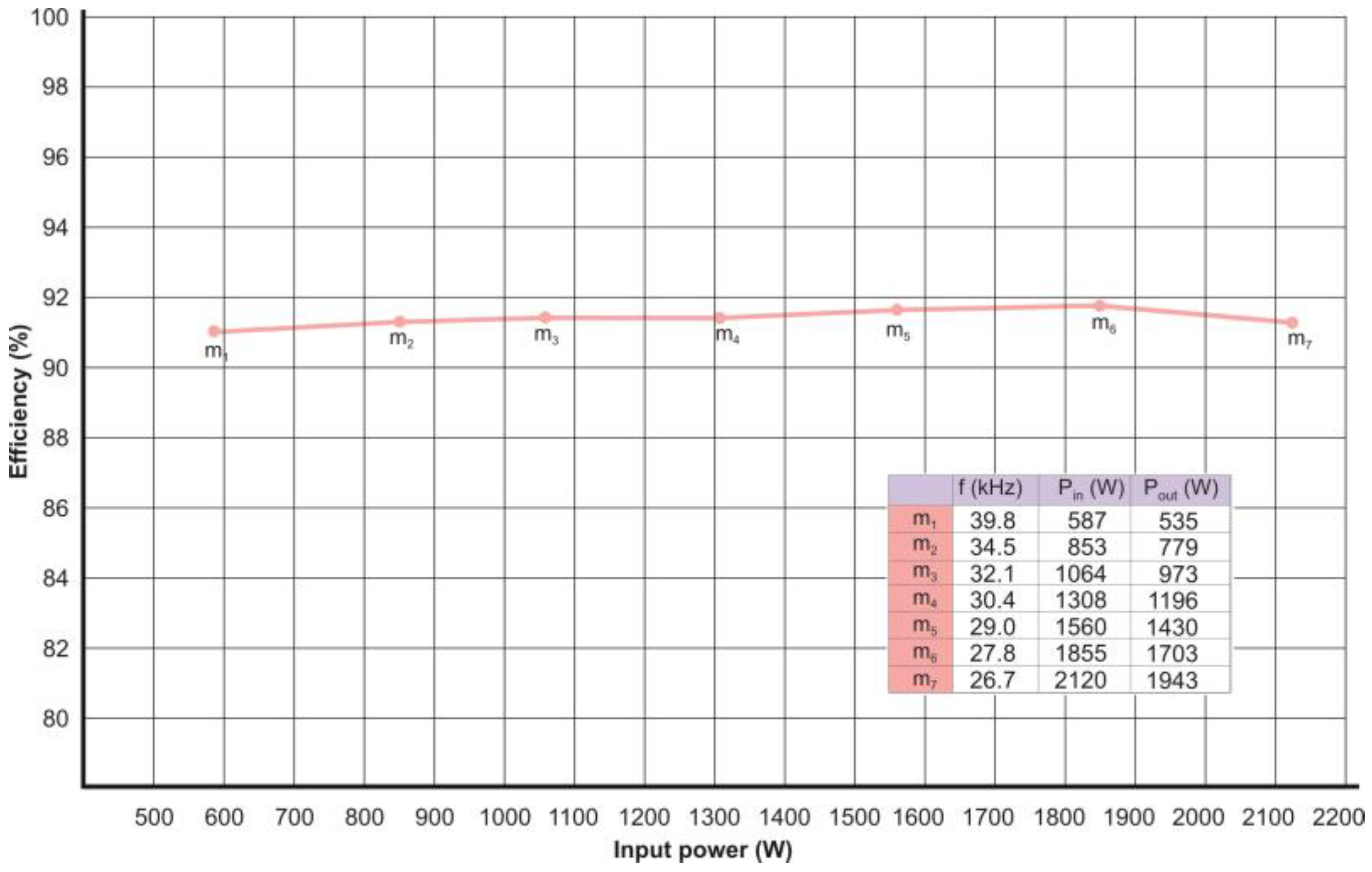
| Applications | POUT [kW] | Top | fSW [kHz] | Device |
|---|---|---|---|---|
| Battery Charger | 1–150 | FB | 20–100 | MOSFET/IGBT |
| Biomedical | 1 | FB | 1000 | MOSFET |
| Robots | 10–60 | FB | 20–40 | IGBT |
| Fixed/Mobil Devices | 0.03–0.3 | HB | 100–400 | MOSFET |
| Small Home Appliances | 0.4–3 | HB | 20–100 | IGBT |
| Reference | Converter | Compensation | η (%) | POUT (W) | Load Range (%) | |
|---|---|---|---|---|---|---|
| Topology | Component | |||||
| [19] | FB | SS | 2C | 79.0–95.0 | 500 | 100/100 |
| [30] | Class E | LCCL | 2C | 81.76 | 72 | |
| [31] | PFC+HB | SCCC | 1Coil+4C | 90.04 | 1300 | 100/100 |
| [32] | SS | 2C | 2200 | |||
| [33] | FB | SP | 2C | 91 | 200 | 100/100 |
| PS | HB | x | x | 90.0–91.8 | 2200 | 10/100 |
| Parameters | Value |
|---|---|
| External diameter | 145 mm |
| Number of turns | 23 |
| Litz wire | 0.25 mm2 × 60 |
| Size of ferrite rods | (5 mm × 60 mm × 15 mm) × 6 |
| (5 mm × 40 mm × 15 mm) × 3 | |
| Coil current (max) | 64 A |
| Frequency | 30 kHz |
| Parameter | Value |
|---|---|
| Mains voltage | 230 V |
| Max output power | 2200 W |
| Max mains current | 9.56 A |
| Resonance frequency | 23 kHz |
| Resonance inductance | 79.3 µH |
| Resonance capacitor | 600 nF |
| Snubber capacitor | 22 nF |
| Max current | 42.18 A |
| Switching frequency | 26 kHz |
| Load resistance | 24 Ω |
Disclaimer/Publisher’s Note: The statements, opinions and data contained in all publications are solely those of the individual author(s) and contributor(s) and not of MDPI and/or the editor(s). MDPI and/or the editor(s) disclaim responsibility for any injury to people or property resulting from any ideas, methods, instructions or products referred to in the content. |
© 2023 by the authors. Licensee MDPI, Basel, Switzerland. This article is an open access article distributed under the terms and conditions of the Creative Commons Attribution (CC BY) license (https://creativecommons.org/licenses/by/4.0/).
Share and Cite
Sezer, C.; Altintas, N. Adaptation of Inductive Power Transfer to Small Household Appliances That Can Operate on Induction Heating Cooktops: Wireless Electric Kettle. Energies 2023, 16, 3544. https://doi.org/10.3390/en16083544
Sezer C, Altintas N. Adaptation of Inductive Power Transfer to Small Household Appliances That Can Operate on Induction Heating Cooktops: Wireless Electric Kettle. Energies. 2023; 16(8):3544. https://doi.org/10.3390/en16083544
Chicago/Turabian StyleSezer, Canberk, and Nihan Altintas. 2023. "Adaptation of Inductive Power Transfer to Small Household Appliances That Can Operate on Induction Heating Cooktops: Wireless Electric Kettle" Energies 16, no. 8: 3544. https://doi.org/10.3390/en16083544
APA StyleSezer, C., & Altintas, N. (2023). Adaptation of Inductive Power Transfer to Small Household Appliances That Can Operate on Induction Heating Cooktops: Wireless Electric Kettle. Energies, 16(8), 3544. https://doi.org/10.3390/en16083544






